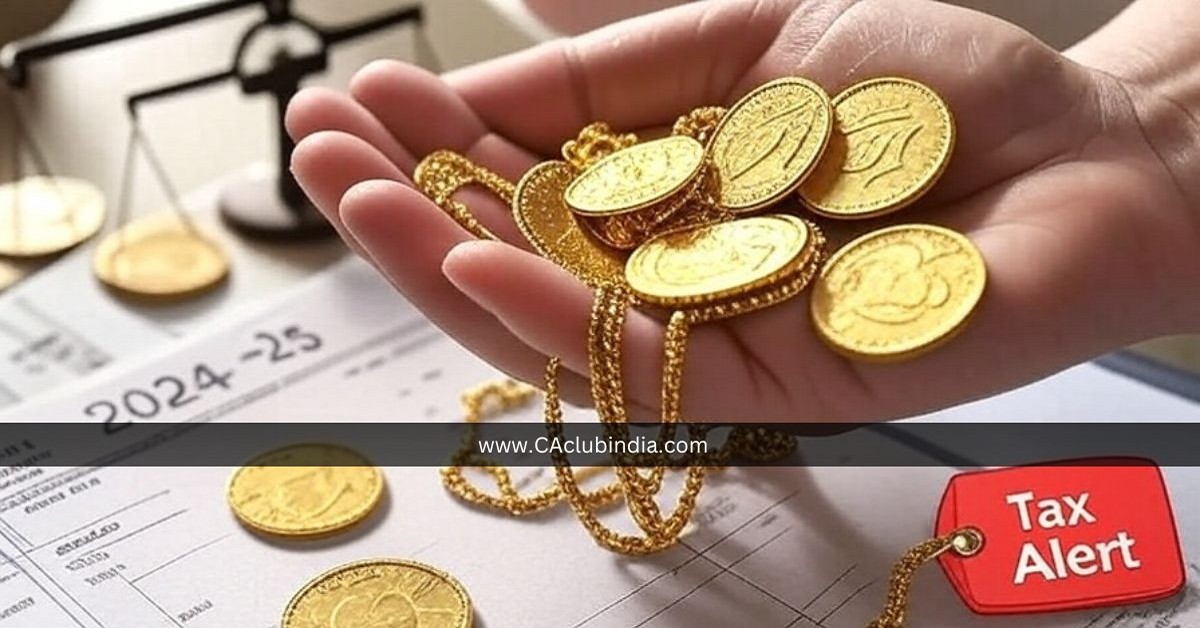Introduction
Gold has always been more than just a shiny asset in India it's a cultural symbol, a family heirloom, and a popular investment choice. But when you sell gold whether as jewellery, bars, coins, or even loose gemstones the profit you make is taxed under "capital gains." To figure out if your gold sale is taxable, the first question is simple: does the item count as a "capital asset"?
Most everyday belongings like furniture or clothing are treated as "personal effects" and escape capital gains tax. Yet jewellery is the notable exception. Anything made of gold, silver, platinum, or similar metals (even if just a thread in a garment), as well as loose precious stones or those set into utensils and decor, is always considered jewellery and therefore a capital asset. By contrast, plain silverware used at home remains exempt so long as it has no embedded stones and isn't being held purely for investment.
Once it's clear you're dealing with a capital asset, the next factor is how long you've held it. Until mid-2024, gold held for three years or less was treated as short-term; anything longer was long-term. But since July 23, 2024, that holding period for short-term has been shortened to two years. Why does this matter? Short-term gains are added to your regular income and taxed at your slab rate, whereas long-term gains enjoy a lower, flat rate (which dropped from 20% with inflation adjustments to 12.5% without them for sales on or after July 23, 2024).
In this article, we'll quickly unpack what counts as taxable gold, show real-life examples of items that qualify (and those that don't), and explain how your holding period determines whether you owe tax at a higher slab rate or a concessional rate for long-term gains. By the end, you'll have a clear, practical roadmap to navigate gold taxation so you can focus on what really matters: choosing the right time to buy, hold, or sell.
Basic Provision of Taxability of Gold
As per Section 45(1) of the Income Tax Act, 1961("the Act"), Any profit and gain arising from transfer of a capital asset shall be chargeable under the head capital gain in the P.Y in which transfer took place.
The taxability of gold is primarily governed by the provisions relating to capital gains under the Income Tax Act, 1961. For any income to be taxed under the head "Capital Gains," the underlying item must qualify as a capital asset as defined under Section 2(14) of the Act. However, if a particular form of gold does not qualify as a capital asset under the law, any gain arising from its transfer would not be taxable under the head capital gains. Thus, the first step in determining taxability is to assess whether the gold in question is treated as a capital asset under the Income Tax provisions.

Whether the Gold is treated as Capital Asset?
As per Section 2(14) of the Act, capital assets means property of any kind held by an assessee, whether or not connected with his business or profession but does not include the personal effects, that is to say, movable property (including wearing apparel and furniture) held for personal use by the assessee or any member of his family dependent on him, but excludes jewellery.
In other words, personal effects are excluded from the definition of capital assets under the Income Tax Act. However, this exclusion specifically does not apply to jewellery. As per the provisions, jewellery is expressly excluded from the definition of "personal effects" and is therefore treated as a capital asset. This means that any gain arising from the sale or transfer of jewellery is taxable under the head "Capital Gains."
Clarifying the Legal Definition of Jewellery in Taxation
Jewellery includes:
- Ornaments made of gold, silver, platinum or any other precious metal or any alloy containing one or more of such precious metals, whether or not containing any precious or semi-precious stone, and whether or not worked or sewn into any wearing apparel;
- Precious or semi-precious stones, whether or not set in any furniture, utensil or other article or worked or sewn into any wearing apparel;
Analysis of the above definition with some practical examples
|
Legal Definition |
Analysis with practical examples |
|
Ornaments made of gold, silver, platinum or any other precious metal or any alloy containing one or more of such precious metals, whether or not containing any precious or semi-precious stone, and whether or not worked or sewn into any wearing apparel; |
Ornaments made of Precious Metals These are items made from gold, silver, platinum, or any other precious metal - either in pure form or as part of an alloy (a metal mixture). It includes even if they contain precious or semi-precious stones or they are stitched or attached to clothes (like a saree border or sherwani embroidery) Examples
|
|
precious or semi-precious stones, whether or not set in any furniture, utensil or other article or worked or sewn into any wearing apparel; |
Precious or Semi-Precious Stones (in any form)
Examples Loose Stones i. You bought a loose diamond to gift later - still counted as jewellery. ii. A ruby kept in your locker as an investment - it's taxable as jewellery. Stones Fixed in Items (Furniture/Utensils/Decor) i. A dining table with embedded emerald stones - considered jewellery. ii. A silver bowl with diamond chips stuck around the edges - it's jewellery. iii. A wooden photo frame with a design using real sapphires - also treated as jewellery. iv. A decorative sword or showpiece with rubies and pearls inlaid - taxable as jewellery. Stitched or Woven into Clothing i. A bridal lehenga with real semi-precious stones stitched on the blouse - its jewellery. ii. A turban (pagdi) with an emerald brooch sewn into it - taxable. iii. A designer dupatta with small real stone work - still considered jewellery. |
Are silver (chandi) utensils used at home considered "jewellery" under the Income Tax Act?
No, they are not treated as jewellery if they are used for personal or household use.
The Following are the reasons:
The Income Tax Act defines jewellery to include:
"Precious or semi-precious stones, whether or not set in any furniture, utensil, or other article, or worked or sewn into any wearing apparel."
But this applies only to stones (like diamonds, rubies, etc.) set in utensils or articles.
Silver utensils by themselves, without any precious or semi-precious stones, are not included in the definition of jewellery, and can qualify as personal effects which are not considered capital assets, and thus not taxable on sale.
Period of holding of Gold- Important to classify the Short Term and Long Term Capital Assets
|
Date of Transfer |
Period of holding |
Type of Capital Asset |
|
Before 23rd July 2024 |
Up to 36 months |
Short-Term Capital Asset |
|
More than 36 months |
Long-Term Capital Asset |
|
|
On or After 23rd July 2024 |
Up to 24 months |
Short-Term Capital Asset |
|
More than 24 months |
Long-Term Capital Asset |
Why is it important to classify the Gold into Short Term Capital Asset and Long Term Capital Asset?
It is important to classify the Gold into Short Term and Long Term Capital Assets because applicable tax rates are different on both short-term and long-term capital assets, which are as follows:
|
Types of Capital Gain |
Date of Transfer |
Tax Rate |
Indexation Allowed |
|
Short-Term Capital Assets |
Any date |
Taxed at slab rates |
Not Applicable |
|
Long-Term Capital Assets |
Before 23.07.2024 |
20% |
Yes |
|
On or after 23.07.2024 |
12.5% |
No |
How to Calculate the Tax on Sale of Gold?
|
Particular |
Short Term Capital Gain (STCG) |
Long Term Capital Gain (LTCG) |
|
Sale Consideration |
xxxx |
xxxx |
|
Less: Cost of Acquisition/Indexed Cost of Acquisition |
(xxxx) |
(xxxx) |
|
Taxable Capital Gain Income |
xxxx |
xxxx |
|
Tax on Capital Gain @ 12.5%/20%/slab rates |
xxxx |
xxxx |
What should be cost of acquisition if Gold is purchased before 01.04.2001
If the Gold is purchased before 01.04.2001 then cost of acquisition shall be calculated as follows-:
- Cost of Purchase of Gold before 01.04.2001
- FMV as on 01.04.2001
Whichever is higher
Conclusion
Gold's dual role as a cherished heirloom and a financial asset means that selling it carries more than just sentimental value. Because jewellery (and even loose precious stones in décor or clothing) is always treated as a capital asset, any gain is taxable, whereas plain silverware without stones and used at home remains exempt. Understanding these definitions is the first step: if your gold item counts as jewellery, it automatically falls under capital gains rules.
Next, the holding period determines your tax burden. Until July 22, 2024, gold held for up to three years was short-term; anything beyond was long-term. Since July 23, 2024, the short-term threshold dropped to two years. Short-term gains simply get added to your income and taxed at your slab rate; long-term gains enjoy a concessional rate (20% with indexation for sales before July 23, 2024, and 12.5% without indexation thereafter).
By keeping these points in mind what qualifies as a capital-gain asset, which items are exempt, and how long you've held them you can plan the timing of your gold purchases and sales to minimize tax. In the end, a little awareness of definitions, holding periods, and rates helps you hold onto more of your hard-earned returns








 CAclubindia
CAclubindia
